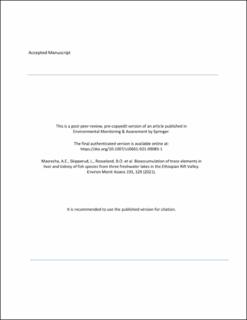| dc.description.abstract | The objective of the present work was to obtain scientific information on the ecological health of three freshwater lakes (Awassa, Koka, and Ziway) situated in the Ethiopian Rift Valley by investigating possible trace element contamination accumulated in fish. Accordingly, fish liver and kidney samples were collected from three commercially important fish species (Barbus intermedius, Clarias gariepinus, and Oreochromis niloticus) in the lakes to determine the concentrations of chromium (Cr), manganese (Mn), cobalt (Co), nickel (Ni), copper (Cu), zinc (Zn), arsenic (As), selenium (Se), cadmium (Cd), and lead (Pb), using ICP-MS. Trace element concentrations were generally higher in O. niloticus compared with concentrations in B. intermedius and C. gariepinus. Compared to background values of most freshwater fish species, higher liver concentrations of Cu in C. gariepinus and O. niloticus, Mn in O. niloticus, Co in all except B. intermedius, and Zn in C. gariepinus from Lakes Ziway and Awassa were found. Cr, Co, Ni, Cd, and Pb were enriched in kidney, while Mn, Cu, Zn, As, and Se seems retained in the liver tissues. Assessment of transfer factors indicated that bioaccumulation from water and diet occurred, while uptake from sediments was low. Furthermore, the transfer factor values were generally higher for essential elements compared to the non-essential elements. Multivariate statistical analyses showed that the differences between the trace element levels were generally not significant among the lakes (p = 0.672), while significant differences were found between the fish species (p = 0.042), and between accumulation in kidney and liver (p = 0.002). | |
